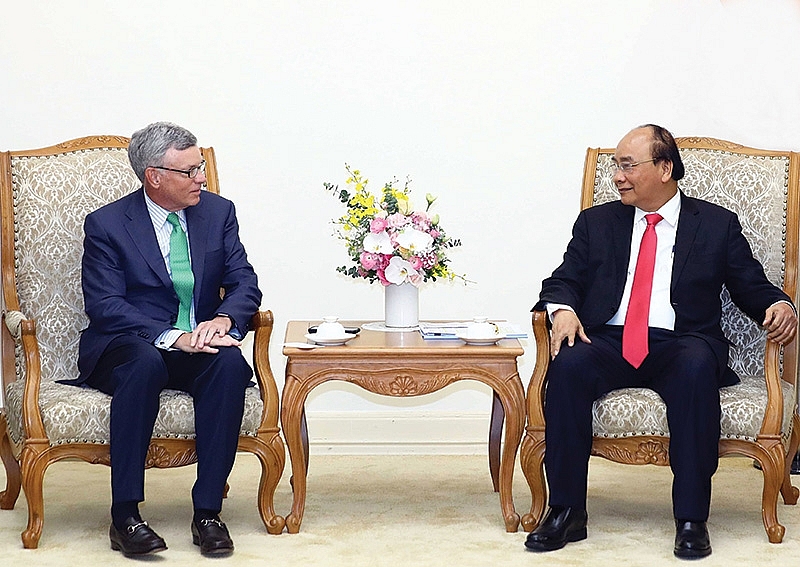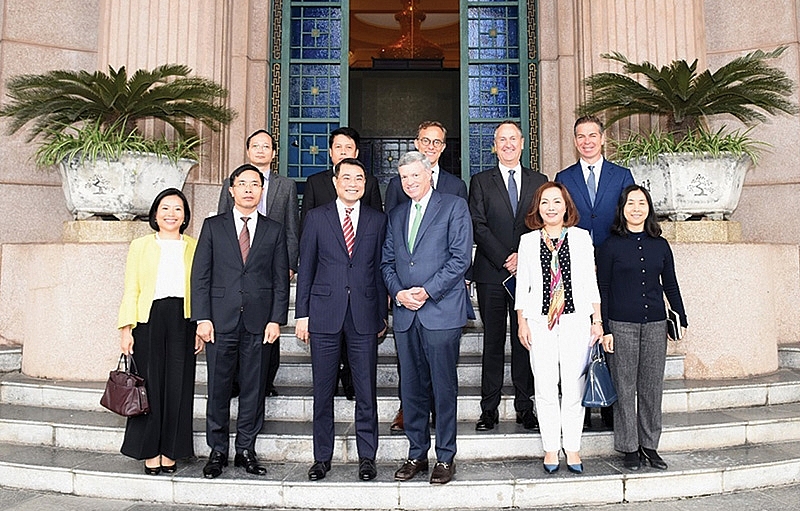Visa facilitating efforts to create cashless Vietnam
 |
| Dang Tuyet Dung |
Why is promoting government payments so important in building out a cashless economy?
Government payments can be categorised into three groups. The first is payments to consumers. This covers social benefits, subsidies or conditional cash transfers, disaster relief, pension or social security, income tax refunds, grants or scholarships, besides development loans, healthcare benefits, employee wages or benefits. This is a very specific payment form of the government.
The second is direct spending by the government. It relates to payments after government procurement contracts to suppliers.
The third is the government receiving payments from the people. It covers taxes, social security, and other contributions, transit payments, and government service fees. This involves huge payment volumes and engages diverse stakeholders and wide-ranging public services such as power, water supply, telecommunications, and insurance.
These payment groups represent almost all basic demands of Vietnamese society, which explains why government payment plays such an important role and why realising the government’s development orientations in this field is vital to achieving the non-cash target.
What are the core benefits of implementing a well-tailored government payment trajectory?
It will bring benefits to the government, people, society, as well as businesses participating in the non-cash payment ecosystem. It helps boost efficiencies in administrative management as the application of non-cash payments and digital technologies provides citizens with more convenient and faster access to funds with efficient payment methods, greater security, and facilitating their inclusion in the financial mainstream.
In respect to government organisations, it boosts procedural savings and efficiencies while helping to reduce paperwork, promote cost savings through consolidated payments, as well as ensure flexible and transparent reporting, improved cash flows, faster delivery of goods and services, and better compliance – all the while being less labour-intensive.
Regarding businesses operating in the non-cash payment ecosystem, the strategy will have to include helping them to reduce billing and payment processing costs while adopting efficient payment methods for improved and more predictable cash flows.
Last but not least, the strategy brings significantly-improved experiences to people and consumers using government payment solutions, providing opportunities to strongly change their attitudes and acclimatise them with new non-cash payment forms. People will also enjoy wider opportunities to access government support.
How can a success be made of promoting the government payment drive?
Non-cash payment solutions applied in government payment would impact all important stakeholders, including banks that present card payment and digital payment forms to later enable cardholders to participate in the payment ecosystem infrastructure, financial institutions that provide payment services infrastructure, each cardholder, and service providers and government agencies that provide government services to consumers.
Additionally, there are the card issuers who provide payment infrastructure, technological solutions, and services supporting the government’s payment services. However, the most essential is the leadership role of the government in ensuring an effective and seamless implementation of a well-conceived government payment strategy and having effective co-ordination among all stakeholders participating in penning out the solutions.
What is Visa’s experiences in helping governments make good on this government payment drive?
The first instance would be the Australian market. Around a decade ago, cash and cheques accounted for about 60 per cent of payments by individuals in Australia, and the adoption rate of technologies was slow. The Australian government looked at new instruments and channels to provide more efficient and better-tailored government payment processes. As a result, Australia’s payment systems in recent decades have facilitated a shift away from manual processes and a decline in the use of cash and cheques .
The Vietnamese market is facing the same challenge. At that point of time, Visa had worked with the Australian government to present a prepaid card solution which is credit-worthy and universally acceptable as cardholders did not need to have a bank account. The solution, which facilitates instant exchange and allows payments when the bank account details are not known to the payer, ensures efficiency gains for various parties.
The second instance is the US market. New York city features a complex system of taxis, trains, ferries, subways, and buses and fare cards cost millions of dollars per year to process. The New York Metropolitan Transportation Authority (MTA) was looking for a better way to collect fare payments. Visa worked with the MTA to present the Visa payWave contactless technology, allowing US commuters to wave or tap their Visa card at a secure terminal to pay.
The programme envisaged full-scale rollout for buses and subways by 2015 with commuter railroads to follow. Its application on New York public transport infrastructure helped achieve all the set expectations and targets on saving the operation and management costs of the city’s public transportation service fees while bringing city commuters more comfort.
Together, MTA and Visa continue to improve the way New York commuters can pay by using mobile and chip technology as the way of the future. The contactless technology has saved New York city in the range of $50 million a year in fare collection costs, as Amy Linden, senior director, New Fare Payment System, at MTA once said.
In other markets like Brazil, New Zealand or India, Visa has been working with the governments in developing seamless payment infrastructure to handle their services.
In Vietnam, developing a government payment system is a priority and Visa, as well as other card organisations, wishes to join the efforts to soon realise the Vietnamese government’s target.
Al Kelly CEO, Visa Inc. Vietnam is one of the fastest-growing markets for Visa across the globe. With a young population, emerging middle class, and consistently strong economic growth, we are very optimistic about the future of digital payments here and the role we can play in supporting Vietnam as it continues on its path to becoming a developed economy. We strongly support Vision 2045 and will continue to partner with our clients, the government, and the broader ecosystem to help Vietnam realise this goal. We have come a long way, but there is still much to do. We are committed to driving financial inclusion, financial literacy, and introducing new payment innovations that will make it faster, more convenient, and more secure for Vietnamese consumers and businesses to pay and be paid.
Visa has launched its Future of Security Roadmap for Vietnam, working closely with the State Bank of Vietnam to design a robust approach for strengthening payments security in the country. Vietnam is at a pivotal time in the evolution of its economy. While the country has a heavy reliance on cash, we are seeing some very positive signs of this changing, including increasing uptake of digital payments such as debit cards and credit cards, the adoption of new payment technologies such as contactless payments, and a rise in e-commerce. We are very excited about the opportunities that lay ahead here in Vietnam and we are proud of our role in helping to develop payment infrastructure in the country. We look forward to working with our clients and the government to continue to grow the expansion of digital payments and position Vietnam as a leading digital economy in the region. |
What the stars mean:
★ Poor ★ ★ Promising ★★★ Good ★★★★ Very good ★★★★★ Exceptional
Related Contents
Latest News
More News
- CONINCO announces new chairman and CEO (December 10, 2025 | 11:00)
- How AWS is powering the next-gen data era (December 09, 2025 | 13:14)
- Outlook in M&A solid for Singapore (December 08, 2025 | 10:31)
- Vietnamese firms are resetting their strategy for global markets (December 05, 2025 | 17:04)
- LPBank Securities accelerates AI and data innovation with AWS (December 05, 2025 | 09:00)
- Improving traceability capacity with Zebra Technologies (November 26, 2025 | 10:08)
- Ho Chi Minh City engages 500 CEOs in dialogue on building global megacity (November 25, 2025 | 16:00)
- CEO shares insights on Phu My 3 IP’s journey to green industrial growth (November 17, 2025 | 11:53)
- NS BlueScope CEO highlights decade of sustainable steel efforts (November 15, 2025 | 10:00)
- SCG maintains strong cash flow and drives low-carbon growth in Q3 (November 07, 2025 | 09:53)



 Tag:
Tag:





















 Mobile Version
Mobile Version